Key Mobile App Industry Statistics in 2025 and Why They Matter
You’ve probably heard the global mobile app industry market was worth around $240 billion in 2023.
But what does this figure mean for you?
Headline figures like the one above don’t make much sense if you are unaware of their relevance and impact.
Can you turn such industry insights into a strategy for success? What steps can you take to claim your slice of the market?
Explore this article to uncover specific mobile app industry statistics and learn actionable ways to leverage them for your benefit — whether you’re planning to set up an app business from scratch or seeking to expand your market or influence through mobile apps.
Let’s jump right in!
Mobile app download figures
From 2016 to 2023, app downloads almost doubled from around 141 billion to around 260 billion. Given that more people are expected to buy smartphones in the coming years, mobile app downloads are expected to rise exponentially in the near future.

Source: Statista
Another crucial and relevant mobile statistic to watch out for is the proportion of free versus paid apps. On both the world’s major app stores, Google Play Store and Apple App Store, more than 90% are free apps. From this, you can infer that an overwhelming number of users prefer downloading free apps over paid apps.
Why these stats matter
The download stats above show there’s a wealth of opportunity available and you can claim your slice of the market by:
- Building an app business using mobile applications
- Augmenting your current business with a free mobile app
- Designing and developing an app with a freemium model
Building an app business using mobile applications
The rise in smartphone use and the increase in mobile app downloads are among the reasons startups like Roamni have established an app business.
Though founders Jason Fabbri and Greg Curcio had no technical background, they had a vision of making local stories more available to more people. With our assistance, they were eventually able to launch the Roamni app and land a partnership with big brands like Formula 1.
Check out the Roamni case study to pick up insights from Greg and Jason’s inspiring mobile app development story.
Ultimately, even if you don’t have any excellent coding skills, building an app business is within reach if you work with the right product development partner.
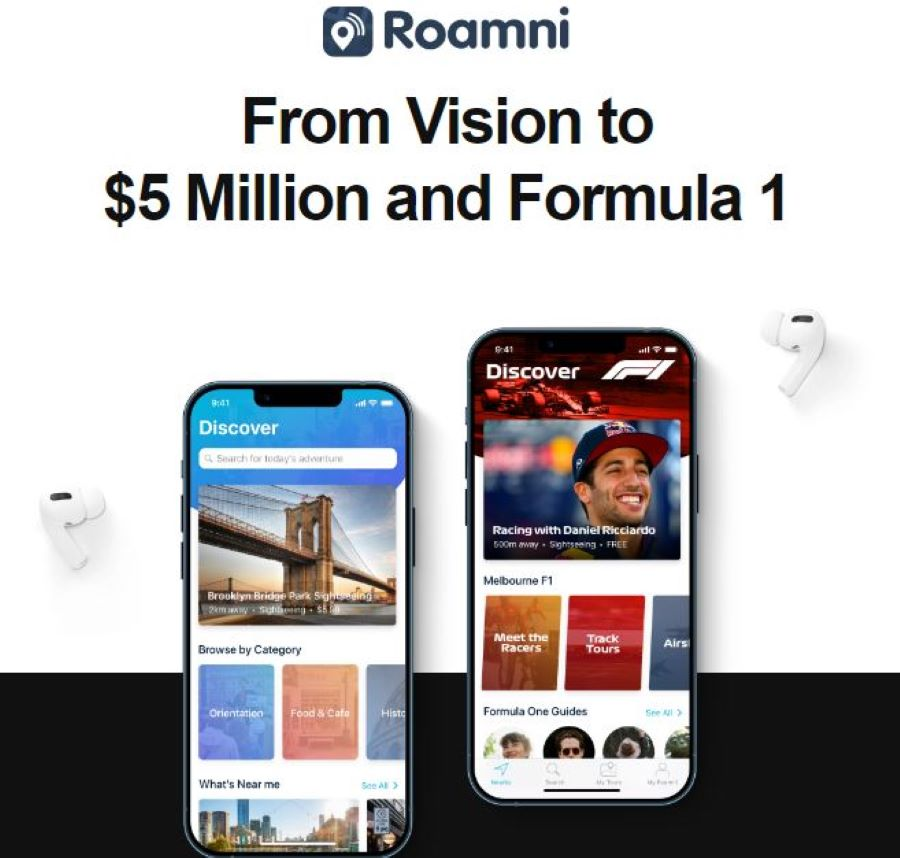
Considering a free mobile app to augment your current business
If you already have a business and envision an app to enhance its efficiency or revenue generation capabilities, you’re better off offering a free app.
That is what Australian ecommerce startup MyDeal did.
MyDeal had been using a web-based marketplace for over a decade when they approached us in 2020 for a unique project.
Seeing that mobile ecommerce statistics point to an increasing number of customers who use smartphones for purchases, MyDeal worked with us so they can add a mobile app to their main online channel. Since MyDeal launched its application, it has not charged a fee for its download.
This makes perfect business sense since the company already earns from seller fees. Besides, since free apps tend to be more popular than paid ones, MyDeal can attract more buyers for its marketplace platform. It’s a win-win.
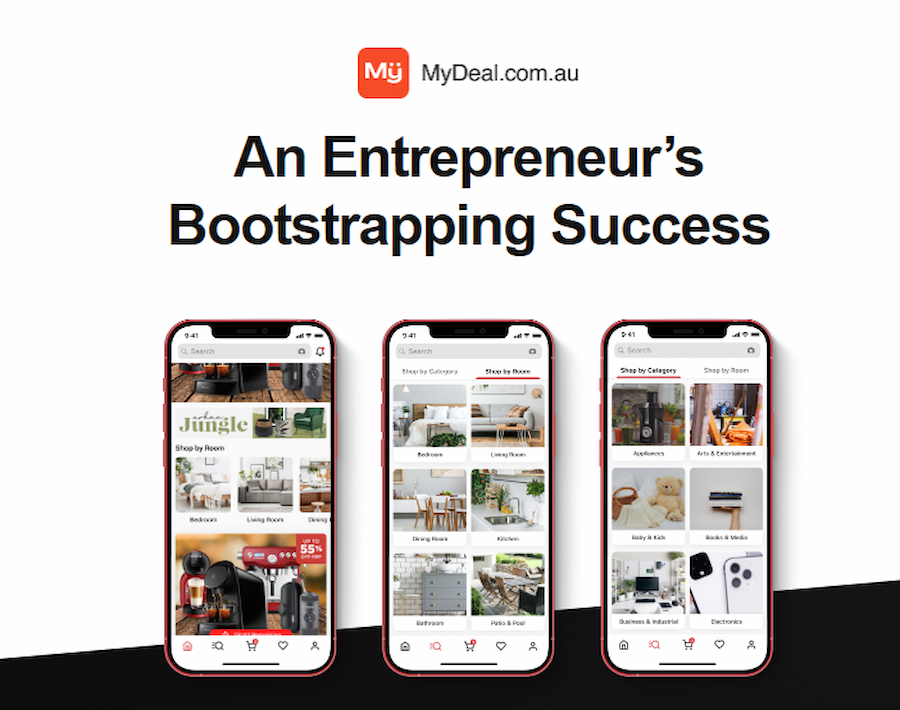
Exploring the design and development of an app with a freemium model
If you’re building an app business from scratch, you can earn even if your mobile app is free or charge money every time someone downloads your app.
But there is a happy middle ground called the freemium model.
The freemium model enables users to download apps and use many features for free while reserving extra bells and whistles for paying customers. Earning income the freemium way is one of many app monetization models you can consider.
Mobile app usage trends
Did you know that the average user doesn’t use 62% of the apps on their mobile device?
Aside from that, people use around 20% of their mobile apps only once.
Why these stats matter
The stats above show that a visually appealing or technically superior mobile app isn’t enough—you also need strategies to engage and retain app users.
Retention means users don’t just use your app once. They keep coming back to it. A high retention rate means the majority of your mobile app users frequently use your app at regular intervals.
It’s good to note that a high retention rate doesn’t necessarily mean people love using your app. They might just need it or have no other viable option. Ideally, you would want your app to have both high retention and engagement rates.

Source: FROGED
Engagement is related to retention but goes a bit deeper. Engaged users don’t just return to your app. High engagement rates mean most people use your app for hours and interact with more than just one screen or menu.
Tips on increasing app retention rate
To ensure that people and businesses keep using your app, you must do the following:
- Use powerful mobile analytics tools to track how often smartphone users open your app
- Make it easy for users to log in and understand your app
- Intelligently leverage push notifications and in-app messaging to remind people that your app exists to help them
For more insights on app retention, check out our carefully written guide on turning new app users into loyal ones.
Tips on increasing app engagement rate
Some measures to maintain high engagement level are:
- Incorporate reward systems to encourage frequent app usage
- Foster in-app communities
- Enable social media integration
One popular method of implementing reward systems is gamification, or the addition of game-like elements to non-gaming applications or platforms. Studies have shown that gamification increases user engagement with mobile apps.
On top of favorable academic research, industry use cases have indicated the advantage of gamification. In fact, an app called Good Empire uses game-like challenges to encourage people to do difficult but planet-saving tasks, like recycling or abstaining from meat eating.
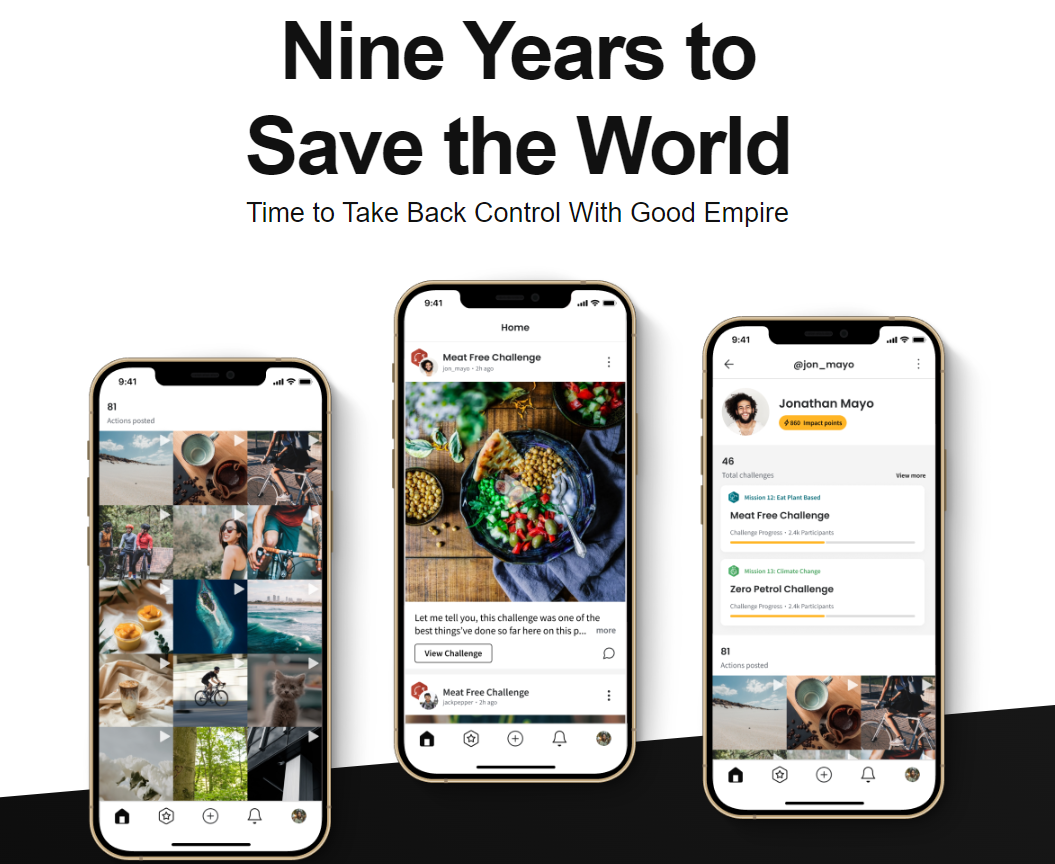
Aside from reward systems, in-app communities and social media have become crucial elements for sustaining user engagement. A case in point is the travel app Vaiva, which fosters an in-app community through a built-in social media feature. These extras augment its main purpose of organizing multiple travel documents in one place.

App store figures
Though there are numerous app stores globally, we will focus on the two largest: the Google Play Store and the Apple App Store.
For context, the apps on Play Store are compatible only with Android devices, while App Store mobile applications only run on iOS phones, tablets, and other similarly designed consumer electronics.
As of writing, the Play Store hosts about twice as many apps as the App Store. But when it comes to gross income from in-app purchases, the App Store earns about twice as much as the Play Store.
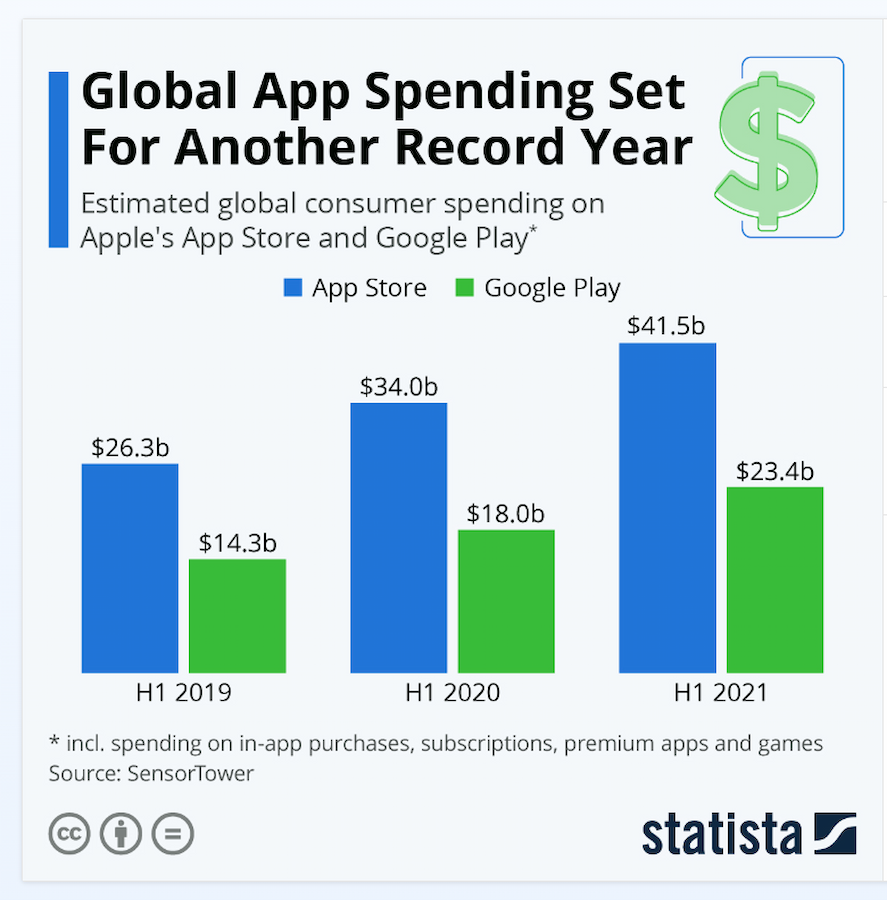
Source: Statista
Why these stats matter
Combine the stats above with the fact that around 71% of the world’s users have Android devices, and you can glean the following insights:
- If you want to maximize your organization’s global reach, develop an app for the Play Store
- If you’re seeking to rely on in-app purchases for income, create a mobile application for the App Store
Earning from in-app purchases
An in-app purchase (IAP) is something you buy within an app—like a digital product, extra feature, or add-on service. This is separate from any initial download fee for paid apps.
Among the many examples of in-app purchases are weapons or “lives” in gaming apps, more precise editing filters in a photo application, and subscriptions to remove ads in a video streaming platform.
If you are seeking to generate income through IAPs, the following mobile app categories have a solid track record for creating revenue within the App Store ecosystem:
- Gaming
- Dating
- Video streaming (Netflix, Hulu, etc.)
- Fitness tracking
- Food delivery apps
Country/region-specific mobile app industry statistics
Asia-Pacific leads the world in terms of share of total mobile app revenue. In 2023, this region accounted for 33% of income from mobile apps. It is followed by North America and Europe, at 30% and 27%, respectively, for the same year.
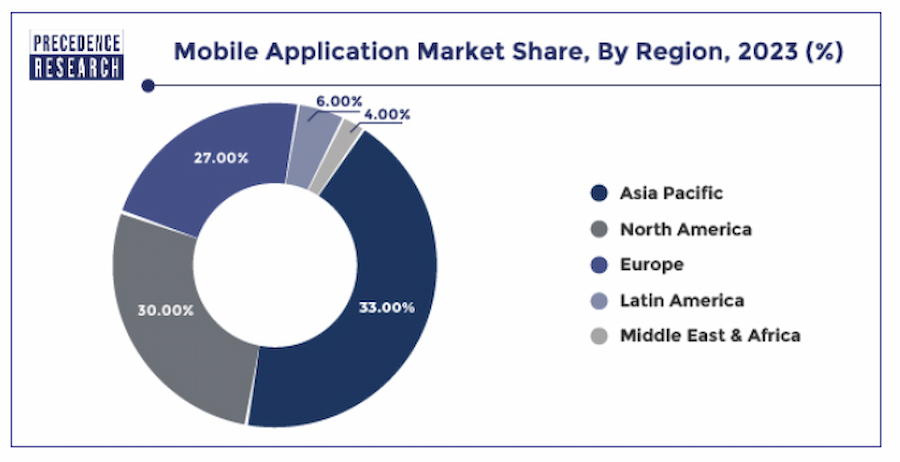
Source: Precedence Research
Income percentage per region is not the only significant statistic to watch out for in the industry. Though Android seems dominant worldwide, it’s worth looking out for specific areas that go against this trend.
The table below shows which 30 countries and territories have more iOS users compared to Android:
| Rank | Country | iOS Market Share | Android Market Share |
|---|---|---|---|
| 1 | Bermuda | 97.47% | 2.5% |
| 2 | North Korea | 97.28% | 2.72% |
| 3 | Faroe Islands | 91.77% | 8.18% |
| 4 | American Samoa | 92.16% | 7.82% |
| 5 | Tokelau | 75.54% | 24.46% |
| 6 | Japan | 69.22% | 30.63% |
| 7 | Andorra | 68.98% | 30.63% |
| 8 | Guernsey | 64.54% | 35.28% |
| 9 | Jersey | 63.91% | 35.38% |
| 10 | Denmark | 61.62% | 37.87% |
| 11 | Monaco | 60.68% | 37.02% |
| 12 | Virgin Islands (US) | 60.18% | 39.6% |
| 13 | Norway | 59.76% | 39.81% |
| 14 | Australia | 59.53% | 39.36% |
| 15 | Isle of Man | 59.38% | 39.67% |
| 16 | Macao | 59.05% | 38.3% |
| 17 | Canada | 58.64% | 40.75% |
| 18 | Belize | 58.31% | 40.52% |
| 19 | United States | 56.93% | 42.64% |
| 20 | Guam | 56.01% | 43.27% |
| 21 | Bahamas | 55.95% | 43.7% |
| 22 | Taiwan | 55.72% | 41.58% |
| 23 | Albania | 55.64% | 44.07% |
| 24 | Switzerland | 54.41% | 44.65% |
| 25 | Gibraltar | 53% | 46.56% |
| 26 | Sweden | 52.88% | 46.7% |
| 27 | Cayman Islands | 51.32% | 47.05% |
| 28 | Liechtenstein | 50.84% | 45.67% |
| 29 | Iceland | 50.06% | 49.38% |
| 30 | United Kingdom | 49.74% | 49.71% |
Why these stats matter
Our product strategists offer these words of advice for anyone just starting to develop an app idea: Start local, go global.
While aiming for global success in app design is great, it’s crucial to start by creating a mobile app that solves the problems of people nearby—like neighbors, colleagues, or local sports groups.
Testing the feasibility of your app idea with a smaller sample in your vicinity can help refine it before considering international expansion. This approach allows you to gather valuable feedback from a more manageable audience, iterate on your app based on local preferences and needs, and build a solid user base and reputation before scaling up globally.
Since your locality is the ideal place to start your digital business empire, it is important to determine whether or not your region or country has a healthy share of the world’s total app revenue. This can help you decide whether you can stay in your home country or transfer your base of operations to ensure sustainable revenue from your app.
You can also check if your region or country is leaning toward Android or iOS so you can better focus your time and resources on developing the right app.
Mobile marketing trends
Mobile marketing is essentially using your target audience’s mobile devices as electronic billboards to promote your products and services. This relatively new method of marketing is on the rise, as proven by the following mobile app industry statistics:
- Global social commerce revenue reached an impressive $570 billion in 2023
- Online video streaming and downloads made up around 80% of Internet traffic in 2022
For other related stats and insights, check out our article on mobile marketing trends.
Why these stats matter
The mobile marketing stats I just discussed underscore the need for strategic marketing techniques when promoting your app, product, or service.
In an age of rapid digital transformation and intense competition, a well-planned marketing campaign is vital to ensure that your organization:
- Launches products or services to market as soon as possible
- Reaches the most number of people in the most cost-effective manner
To achieve these two goals, it is crucial to implement a pre- and post-launch app marketing strategy, leverage social commerce, and consider video marketing.
Implement a pre- and post-launch marketing strategy
Implementing your mobile app’s marketing strategy before, during, and after development is crucial so you will have a large pool of users waiting by the time you launch your application. Since you have been building up awareness about your app, it can quickly gain market traction, reducing costs and maximizing revenue on your end.
Leverage social commerce
Social commerce is the use of networking platforms like Facebook, Instagram, etc., to promote your app, products, or services.
As of April 2024, the world has around 5 billion social media users. The sheer number of eyeballs on social media apps gives you a cost-effective way to start a conversation with a large number of potential customers. The fact that many social media accounts are free makes social commerce among the least expensive ways to reach a massive audience at once.

Source: Statista
Consider video marketing
When finding an audience for your idea or product, videos are among the most effective tools.
The power of video marketing to increase sales relies partly on the ever-shortening attention span of the average person, which is currently at around 10 seconds.
Since a picture is worth a thousand words, a series of moving pictures in videos can compress long ideas into a short audiovisual treat to keep your potential customers engaged.
Aside from their ability to “shrink time,” videos’ capacity to form emotional connections makes them potent tools for promoting products and services. After all, most purchasing decisions are driven by emotions instead of pure logic.
Beyond mobile app industry statistics
As you’ve just read, mobile app industry statistics have buried insights that are as worth digging as gold. Hopefully, this article was able to give you not just numbers, but also practical insights you can use to achieve your goals in business, app development, or any other relevant endeavor.
Remember, insights are not just passive information. You can use them as the foundation for turning your deep-seated passion into something marketable.
I’ve mentioned before that the founders of Roamni built a mobile app with no technical background. MUCUDU’s visionaries were also the same, running more on passion than programming proficiency. Yet they have created a mobile app that has revolutionized how bars and venues connect with patrons.

These brave entrepreneurs went beyond insights and jumped toward action.
But they didn’t do so alone.
MUCUDU, Roamni, and other startups brought their vision to life by collaborating with us at Appetiser Apps.
Our dream team of product strategists knows the most relevant statistics and insights to help you reach your goals. We also have developers who can build the most user-friendly and robust digital products to help you lead in your industry or maximize your social impact.
Be a star amongst a constellation of mobile app industry champions. Contact us for a free consultation, and let’s work toward turning stats into success.

Jesus Carmelo Arguelles, aka Mel, is a Content Marketing Specialist by profession. Though he holds a bachelor’s degree in business administration, he also took courses in fields like computer troubleshooting and data analytics. He also has a wealth of experience in content writing, marketing, education, and customer support.


